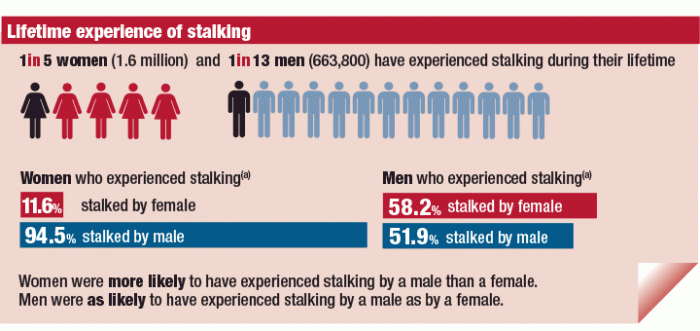The 2012 Personal Safety Survey (PSS) collected information from men and women aged 18 years and over about their experience of stalking by a male and by a female. Stalking is defined by a range of behaviours which the person believed were undertaken with the intent to harm or frighten them. Behaviours include loitering, watching and following, interfering with or damaging a person's property, leaving material for the person that is offensive, being telephoned, sent mail or contacted electronically with intent to harm or frighten.
Image

Description
- 1 in 5 women (1.6 million) and 1 in 13 men (663,800) have experienced stalking during their lifetime.
- Women were more likely to have experienced stalking by a male (94.5%) than by a female (11.6%)(a).
- Men were as likely to have experienced stalking by a male (51.9%) as by a female (58.2%)(a).
Image

Description
The following groups were more likely to experience stalking in the 12 months:
- Females (4.1%) compared to males (1.8%).
- Persons born in Australia (3.7%) compared to persons born overseas (1.9%).
- Persons aged 18-54 years (3.9%) compared to persons aged 55 years and over (1.6%).
- Unmarried persons (4.9%) compared to married persons (2.1%).
Image

Description
- Both men and women were more likely to have experienced stalking by someone they knew than by a stranger.
- An estimated 68% of women who experienced stalking by a male and 82% of women who experienced stalking by a female knew the stalker.
- An estimated 59% of men who experienced stalking by a male and 87% of men who experienced stalking by a female knew the stalker.
Image

Description
- Men were more likely to perceive stalking as a crime when they were stalked by a male (55%) than by a female (18%).
- Women were equally likely to perceive stalking by males and females as a crime (both 47%).
Image

Description
- Less than half of persons who have experienced stalking contacted the police about the most recent episode of stalking.
- An estimated 42% of women who experienced stalking by a female and 37% of women who experienced stalking by a male contacted the police.
- An estimated 21% of men who experienced stalking by a female and 53% who experienced stalking by a male contacted the police.
Image

Description
- Women were more likely to experience anxiety or fear as a result of stalking than men.
- An estimated 42% of men stalked by a male and 28% of men stalked by a female experienced anxiety or fear in the 12 months after the most recent episode of stalking.
- An estimated 62% of women stalked by a male and 54% of women stalked by a female experienced anxiety or fear in the 12 months after the most recent episode of stalking.
Image

Description
- Of women who experienced stalking by a female, an estimated 48% reported the most recent episode of stalking lasted for less than 6 months, 28% reported that it lasted between 6 months and 2 years, and 24% reported that it lasted for 2 years or more.
- Of women who experienced stalking by a male, an estimated 56% reported the most recent episode of stalking lasted for less than 6 months, 29% reported that it lasted between 6 months and 2 years, and 15% reported that it lasted for 2 years or more.
- Of men who experienced stalking by a female, an estimated 50% reported the most recent episode of stalking lasted for less than 6 months, 34% reported that it lasted between 6 months and 2 years, and 16% reported that it lasted for 2 years or more.
- Of men who experienced stalking by a male, an estimated 56% reported the most recent episode of stalking lasted for less than 6 months, 28% reported that it lasted between 6 months and 2 years, and 16% reported that it lasted for 2 years or more(f).